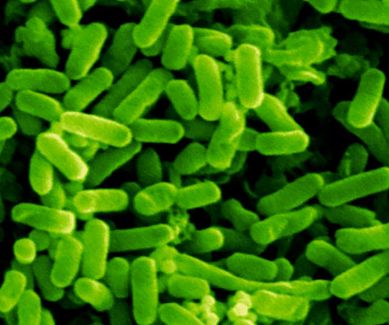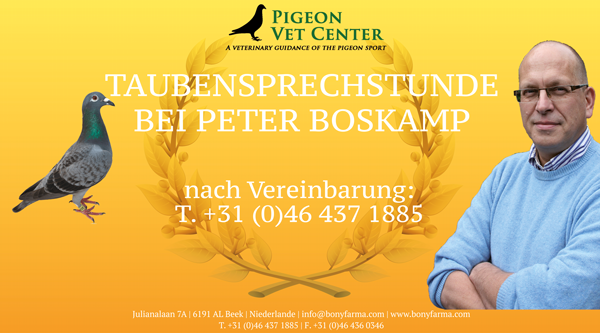In MAY 2024 – by Dr. Peter Boskamp...

E.Coli (Escherichia Coli)
There are a number of bacteria in pigeons that can cause illness, but do not do so in all circumstances. We call these bacteria: facultative pathogenic bacteria. In principle, they can lead to illness and sometimes even death, but this only happens when conditions become more favorable for the bacteria. Under these conditions the bacteria can multiply quickly. The bacterium E. coli is one such bacterium. In the vast majority of cases, however, we still consider this bacterium to be part of the normal intestinal flora of pigeons. This bacterium is often found during routine fecal examinations. Usually there are no symptoms at all. However, some veterinarians advise against it. There are doubts about that.
Escherichia coli is a so-called gram-negative rod bacterium that belongs to the Enterobacteriaceae family. This family also includes the Proteus bacteria and the Klebsiella bacteria, but also Salmonella.
There are many different strains of E. coli bacteria. Many of these strains can be considered as intestinal commensals. So benign intestinal bacteria. In addition, there are opportunistic strains that, as mentioned, can become pathogenic given the opportunity. Finally, some strains are primarily pathogenic. These can cause diarrhea or infections of the internal organs.
So it's not the case that you always have to think about pathogenic bacteria when E. coli is detected in a fecal sample. Certainly not if they are found during a routine examination in the feces of pigeons that are otherwise not sick. The situation is different with diarrhea, where large amounts of E. Col bacteria are present per ml of feces. This can occur in young pigeons infected with adenovirus in spring.
There are so many different strains of E. Coli that microbiology attempts to distinguish these different strains based on the so-called antigenic properties of these coli bacteria. In practice this means O, H and K antigens. For an E. Coli found in chickens, the name may be E. Coli O1:K1:H7. In this way, hundreds of different strains can be distinguished. In this way we try to continue to see the forest between the trees.
Routine research does not typically examine which strains we are dealing with.
However, the same strains occur in sick and healthy pigeons. This means that pigeons can become ill under favorable conditions for this bacterium. Therefore, it is important to try to prevent these circumstances.

Symptoms of the disease
E. coli can cause acute blood poisoning in pigeons, which can quickly lead to the death of the animals. We often see this with small nestlings. Breeders often think of salmonella infection. However, there are several bacteria that can cause this acute nest death. To determine the cause, further examinations are often not superfluous. Death in the egg can also occur. Even then, the pathogen can often be detected if the eggs are further examined.
Acute death from E. coli sepsis cannot only occur in nestlings. This can occur in pigeons of all ages. Sometimes it only results in acute death. In other cases, diarrhea and vomiting or weight loss occur.
However, it is difficult to determine the exact cause of blood poisoning based on symptoms alone. Further bacteriological research is therefore desirable. The bacteria must then be detected in the internal organs. The autopsy picture can be the same for several causes of blood poisoning.
It must be emphasized again that making a diagnosis based on a fecal test alone is completely pointless. Finally, coli bacteria are also found in the feces of healthy pigeons. In order to make a reliable diagnosis, the bacteria must be detected in the organs.
Stress factors often play a role in the development of coli sepsis. The stress reduces the pigeons' resistance, which increases the chances of facultative pathogenic bacteria.
Among these stress factors we can include overpopulation. However, the breeding season is also a time when infection pressure can increase. If there is a major nest death during the breeding season, we prefer to detect the pathogen by isolating the germ. We monitor the isolation of the germ by creating an antibiogram. Slices containing a small amount of antibiotics are placed on a smear of the isolated bacteria in a so-called Petri dish. This way we can determine the most effective antibiotic. Experience shows that many of the E. coli strains are insensitive to many of the antibiotics used.
It is therefore important to provide the right resources. In these cases of high nest mortality, an action plan is required to prevent recurrence of mortality in subsequent breeding rounds.
Part of this approach is to reduce the infection pressure from E. Coli. Many years of experience have shown that acidifying drinking water can be very effective here. But providing probiotics to increase competition between bacteria in the gut and trying to restore balance in the gut can also help.
This approach also works with an increased number of pigeons of different ages that suddenly die. If massive problems occur with the pigeons, general antibiotic therapy is necessary. If only a few pigeons are affected, we often achieve even better results with individual treatment of the affected pigeons, supplemented by the therapy of acidifying the drinking water in combination with the administration of probiotics. In both cases, the aim is to reduce the infection pressure of E. Coli, which is often due to a disturbance in the balance in the intestine.
The advantage of the acidification and probiotics approach may be that we begin to restore the balance of the intestinal flora immediately, while also putting pressure on the remaining intestinal flora with the first administration of antibiotics.
But here too, which approach is best varies from case to case and depends on the circumstances. There can be arguments for and against both treatment methods. Personally, I prefer the more natural approach to this disease due to the resistance issues that play a role with E. Coli.
A particular problem with this E. coli problem occurs during the maturation of young pigeons when they fall prey to the adenovirus. These pigeons in particular seem to be sensitive to this E. coli problem. But here too, the approach remains the same for us. If you have 100 young pigeons and around 30 of them suddenly develop diarrhea and vomiting, you should usually resort to medication as quickly as possible to treat the pigeons. In this case it makes sense. Because if a fire breaks out, drastic measures are required. Acidifying the drinking water and probiotics help to solve the problem more quickly, but the infection pressure is then so high that the administration of antibiotics seems necessary.
However, what we have been able to determine over the last 25 years is that when this disease breaks out, the young pigeons' resistance is promoted and the drinking water is regularly acidified.
For a hundred pigeons there are not 30, but maybe 4-5 problems. Due to the rapid isolation and individual treatment, it is usually possible in practice not to have to treat all pigeons at the same time. The pigeons treated individually in this way can be better prosecuted. I therefore recommend that you note the number of these pigeons, as practice often shows that these pigeons are later chosen first.
The pigeons, which are so strong that they don't actually need antibiotics, do not receive them so that their intestinal flora is not unnecessarily burdened with antibiotics. The pigeons that need antibiotics to survive receive them, but this means they can be better monitored. The end result is less use of antibiotics, but also an increase in selection options because the weaker brothers can be removed earlier. The portfolio will benefit from this in the long term.
Shortly.
E. Coli is a bacteria that can cause major problems in pigeons. But it is also one of the bacteria that can be kept in check with good batting posture and a natural approach. In this case, preventive health care will ultimately help the pigeons than the curative approach with antibiotics that has become necessary.
Good luck,
Peter Boskamp





